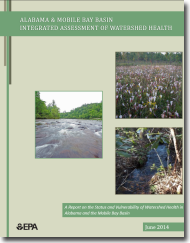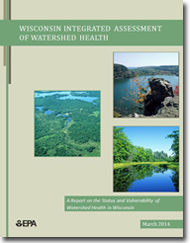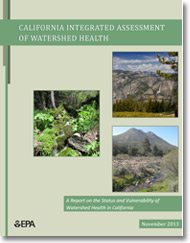Basic Information and Answers to Frequent Questions
- What is a watershed?
- What is a healthy watershed?
- Are healthy watersheds very common?
- How might healthy watersheds affect me?
- Why do watersheds need to be protected?
- Why is EPA concerned with healthy watersheds?
- What is being done to protect healthy watersheds?
- How is a healthy watershed identified?
- What is evaluated in a healthy watersheds assessment?
- How much healthy watersheds assessment has been done in the U.S.?
What is a Watershed?
A watershed – the land area that drains to one stream, lake or river – affects the water quality in the water body that it surrounds. Like water bodies (e.g., lakes, rivers, and streams), individual watersheds share similarities but also differ in many ways. Every inch of the United States is part of a watershed – in other words, all land drains into a lake, river, stream or other water body and directly affects its quality. Because we all live on the land, we all live in a watershed — thus watershed condition is important to everyone.
Watersheds exist at different geographic scales, too. The Mississippi River has a huge watershed that covers all or parts of 33 states. You might live in that watershed, but at the same time you live in a watershed of a smaller, local stream or river that flows eventually into the Mississippi. EPA’s healthy watersheds activities mainly focus on these smaller watersheds.
What is a Healthy Watershed?
- dynamic hydrologicPertaining to the science dealing with the properties, distribution, and circulation of water. and geomorphologicPertaining to the study of physical landscapes (landforms) and the processes that create and mold them. processes within their natural range of variation,
- habitat of sufficient size and connectivity to support native aquatic and riparianAreas adjacent to rivers and streams. These areas often have a high density, diversity, and productivity of plant and animal species relative to nearby uplands. species, and
- physical and chemical water quality conditions able to support healthy biological communities.
Natural vegetative cover in the landscape, including the riparian zone, helps maintain the natural flow regime* and fluctuations in water levels in lakes and wetlands. This, in turn, helps maintain natural geomorphic processes, such as sediment storage and deposition, that form the basis of aquatic habitats. Connectivity of aquatic and riparian habitats in the longitudinal, lateral, vertical, and temporal dimensions helps ensure the flow of chemical and physical materials and movement of biotaThe animal and plant life of a given region. among habitats.
- intact and functioning headwater streams, floodplains, riparian corridors, bioticOf or pertaining to living organisms. refugiaAn isolated place of relative safety from danger and hardship; the only remaining high quality habitat within an area., instream habitatA place where the physical and biological elements of ecosystems provide a suitable environment including the food, cover, and space resources needed for plant and animal livelihood., and biotic communities;
- natural vegetation in the landscape; and
- hydrology, sediment transport, fluvial geomorphology, and disturbance regimes expected for its location.
*A stream’s flow regime refers to its characteristic pattern of flow magnitude, timing, frequency, duration, and rate of change. The flow regime plays a central role in shaping aquatic ecosystems and the health of biological communities. Alteration of natural flow regimes (e.g., more frequent floods) can reduce the quantity and quality of aquatic habitat, degrade aquatic life, and result in the loss of ecosystem services.
Are Healthy Watersheds Very Common?
Unfortunately not. Healthy watersheds are uncommon, particularly in the eastern U.S. as well as in most other parts of the nation that are urbanized, farmed, or mined. Large tracts of protected wildlands, mostly in the western U.S., are where most healthy watersheds can be found. However, some healthy watersheds exist in many regions of the country where water pollution has been prevented or well controlled, and where communities maintain the benefits of their clean waterways.
How Might Healthy Watersheds Affect Me?
- Healthy watersheds are necessary for virtually any high quality outdoor recreation sites involving the use of lakes, rivers, or streams. Great fishing opportunities are usually due to healthy watersheds that surround the waters that people love to fish.
- Your drinking water, if it comes from a surface water source, might be substantially less expensive to treat, if a healthy watershed around the water source filters pollution for free.
- Your property values may be higher, if you are fortunate enough to reside near healthy rather than impaired waters.
You and your community’s quality of life may be better in these and other ways due to healthy watersheds; now, imagine how unhealthy watersheds might affect you as well.
Why Do Watersheds Need to Be Protected?
Healthy watersheds not only affect water quality in a good way, but also provide greater benefits to the communities of people and wildlife that live there.
A watershed – the land area that drains to a stream, lake or river – affects the water quality in the water body that it surrounds. Healthy watersheds not only help protect water quality, but also provide greater benefits than degraded watersheds to the people and wildlife that live there. We all live in a watershed, and watershed condition is important to everyone and everything that uses and needs water.
Healthy watersheds provide critical services, such as clean drinking water, productive fisheries, and outdoor recreation, that support our economies, environment and quality of life. The health of clean waters is heavily influenced by the condition of their surrounding watersheds, mainly because pollutants can wash off from the land to the water and cause substantial harm.
Streams, lakes, rivers and other waters are interconnected with the landscape and all its activities through their watersheds. They are influenced by naturally varying lake levels, water movement to and from groundwater, and amount of stream flow. Other factors, such as forest fires, stormwater runoff patterns, and the location and amount of pollution sources, also influence the health of our waters.
These dynamics between the land and the water largely determine the health of our waterways and the types of aquatic life found in a particular area. Effective protection of aquatic ecosystems recognizes their connectivity with each other and with their surrounding watersheds. Unfortunately, human activities have greatly altered many waters and their watersheds. For example:
- Over the last 50 years, coastal and freshwater wetlands have declined; surface water and groundwater withdrawals have increased by 46%; and non-native fish have established themselves in many watersheds (Heinz Center, 2008).
- A national water quality survey of the nation's rivers and streams showed that 55% of the nation's flowing waters are in poor biological condition and 23% are in fair biological condition (U.S. EPA, 2013). Compared to a 2006 survey (U.S. EPA, 2006), which only assessed wadeable streams, 7% fewer stream miles were in good condition.
- Nearly 40% of fish in North American freshwater streams, rivers and lakes are found to be vulnerable, threatened or endangered; nearly twice as many as were included on the imperiled list from a similar survey conducted in 1989 (Jelks et al., 2008)
- Rainbow trout habitat loss from warmer water temperatures associated with climate change already has been observed in the southern Appalachians (Flebbe et al., 2006).
Why is EPA Concerned with Healthy Watersheds?
One of EPA’s most important jobs is to work with states and others to achieve the Clean Water Act’s primary goal – restore and maintain the integrity of the nation’s waters. Despite this law’s many pollution control successes, tens of thousands of streams, rivers and lakes have been reported as still impaired. The great majority of these involve pollution sources in their watersheds – the land area that surrounds and drains into these waters. Knowing the conditions in watersheds is crucial for restoring areas with degraded water quality, as well as protecting healthy waters from emerging problems before expensive damages occur.
Achieving the Clean Water Act’s main goal depends on having good information about watersheds – their environmental conditions, possible pollution sources, and factors that may influence restoration and protection of water quality. EPA is investing in developing scientifically sound and consistent data sources, and making this information public and easily accessible to the wide variety of our partners working toward clean and healthy waters.
What is Being Done to Protect Healthy Watersheds?
A very wide range of activities could be called healthy watersheds protection. These may include regulatory and non-regulatory approaches. EPA’s healthy watersheds protection activities are nonregulatory. Approaches used at state and local level could be either. The private sector is also actively involved in many forms of protection.
- emerging water quality problems,
- loss and fragmentation of aquatic habitat,
- altered water flow and availability,
- invasive species, and
- climate change.
How is a Healthy Watershed Identified?
There are literally hundreds of watershed characteristics (such as environmental traits, sources of degradation, and community factors) that may influence environmental health and quality of life, for better or worse. Identifying and comparing these characteristics is known as watershed assessment. This process is the main way to compare watershed condition across large areas such as states, and find the healthy watersheds among the rest.
What is Evaluated in a Healthy Watersheds Assessment?
EPA’s process for assessing healthy watersheds looks at small scale watersheds – either catchments (which average about one square mile in area) or HUCA unique code, consisting of two to eight digits (based on the four levels of classification in the hydrologic unit system), that identifies each hydrologic unit.12 watersheds (which average about 35 square miles in area). The factors for describing and comparing watersheds, called indicators, are selected specifically for the area of the country being studied. Although custom selections of indicators are made to suit the study area, all assessments develop a comparative index of watershed health and index of watershed vulnerability. These complementary indices help states and other users find out where the healthiest watersheds are, and also what their level of vulnerability might be.
How Much Healthy Watersheds Assessment has been Done in the U.S.?
Several states have developed statewide assessments of their healthy watersheds on their own over the past decade. EPA has partnered with states and watershed groups in several additional locales to generate more statewide watershed assessments. However, in many states, there are still no completed studies to identify the healthy watersheds or their vulnerabilities. EPA is currently working to provide these states with preliminary healthy watersheds assessments.
of Watershed Health






